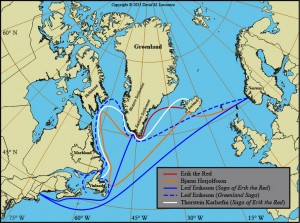The Saga of Erik the Red

This woodcut of Erik the Red was taken from the frontispiece of Arngrímur Jónsson’s Gronlandia (1688).
MECHANICSVILLE, Va.—The Saga of Erik the Red documents the first sustained European contacts with North America from the latter part of the tenth century to the beginning of the eleventh.
Lest anyone counters that the Norse left no permanent settlement in North America, I should point out that Greenland—the Earth’s largest island—is technically a part of the North American continent. The Norse may not have realized it at the time, and many U.S. geography students as well as FFVs (First Families of Virginia) may not want to acknowledge the truth, but it is.
Tectonically, Greenland is a part of the North American plate. Culturally, the indigenous Inuit had longstanding trade ties with their fellow Inuit as well as other native peoples in North America. It was an accident of history that Greenland, now governed by Denmark, was colonized by Europeans.
This accident brings us to The Saga of Erik the Red. Erik’s story (not the saga itself) begins with the expulsion of Erik’s father from Norway to Iceland on account of a manslaughter rap. Erik was similarly expelled from Iceland—the inciting incident that led to Erik’s relocation to Greenland. He finds it worthy of a colony and sends word back to Iceland to encourage others to settle there.
Erik engages in what twenty-first century scholars might call a disinformation campaign to promote the colony, much of which is capped by glaciers, with waters are full of icebergs and a very short growing season. But Erik called it Greenland because, “… men would be the more readily persuaded thither if the land had a good name (Saga of Erik the Red 1906, 17).”
The next phase of the story concerns Erik’s son, Leif, who was a member of Norwegian king Olaf Tryggvason’s court. While with King Olaf, Leif converted to Christianity and was dispatched by the king to Christianize the Norse living in the Greenland settlements. While on that voyage, Leif, off-course like his father, finds land to the west of Greenland. He briefly visits, where he finds “… self-sown wheat fields and vines … (25),” and a few marooned Norsemen. Leif rescued the marooned men and leaves for Greenland, where he begins his proselytizing efforts, but also plans a return to the land to the west.
The final phase of the story recounts the Vineland colonization efforts conducted by Leif, his brother Thorvald, and subsequently by Thorfinn Karlsefni.

Map of the routes taken by several Norse explorers (intentional or otherwise) to North America in the tenth and eleventh centuries. Redrawn from other sources. Projection is Lambert Conformal Conic with standard parallels of 50 and 70 degrees North latitude. Nominal scale is 1:32,500,000.
On one hand the saga is fascinating, although the prose translation probably loses much of the drama and poetry that a story meant to be transmitted orally should carry.
But what is more troublesome—for me, at least—is the mishmash of genealogy, history, and magic that runs through the saga.
The genealogical aspect is the biggest hurdle to following the story. There are a profusion of names, many of which are similar, which—despite several readings—makes it hard for me to keep track of the key players and the related narrative threads.
Another problem is, being that the saga was not meant to serve as a geographical guide, essential detail about locations of Vinland and related sites visited or settled by the Norse is omitted. The lack of detail has inspired centuries of searches for the sites of the Norse settlements in the so-called “New World.” While diligent archaeological research has identified some settlement sites, such as L’Anse aux Meadows in Newfoundland (Wallace 2009), most purported sites remain highly controversial.
The saga strikes me as at its best when it focuses on the drama of the human endeavor called exploration. The storms, conflict, illness, and death—even its conjurings of oracles and ghosts—that run through the narrative should make The Saga of Eric the Red a tale that will be remembered long after drier, more academic histories have been pulled from library shelves and pulped.
REFERENCES
“The Saga of Eric the Red.” 1906. Translated by Arthur Middleton Reeves. In The Northmen, Columbus and Cabot, 985-1503: The Voyages of the Northmen, edited by Julius E. Olson and Edward Gaylord Bourne, 14-44. New York: Charles Scribner’s Sons.
Wallace, Birgitta. 2009. “L’Anse Aux Meadows, Leif Eriksson’s Home in Vinland.” Journal of the North Atlantic no. 2 (sp2):114-125. doi: 10.3721/037.002.s212.
